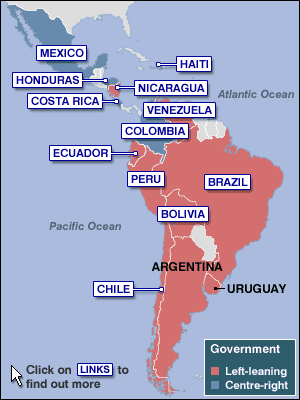What explains the rise of the contemporary left in Latin America Since 2005?
Chavez and The Beginning of the Return
The political left in Latin America has seen a remarkable return to popularity in recent years. The scarcity of victories for contemporary left leaning parties throughout Latin America during the 1980’s and most of the 1990’s had led many commentators to believe the left was effectively dead in that part of the world. However, since Hugo Chavez’s victory in the Venezuelan elections of 1998 leftist victories have become increasing common, leading to the successful creation of left leaning governments in nine out of fourteen elections held in Latin America between 2005 and 2007.
As has already been noted following the success of Chavez in Venezuela in 1998 the left had a remarkable run of success and this led to eleven of the eighteen countries that constitute Latin America being governed by the electoral left. Initially these successes were viewed as isolated incidents that were freak results following the dirge of success for the left in the twenty years preceding the Chavez victory and it took a while until he became apparent that it was not a few isolated successes but a regional trend.
Hugo Chavez

The Centre Left
The reason it took so long for the trend to be recognised was due to the perceived differences within the left between the more radical populist left and the social-democratic left but it now recognised that these differences are less pronounced than previously believed within the Latin American political system. According to Dr Matthew Cleary “These differences within the left, while real, are often overemphasized. In contrast to how it is sometimes perceived in the press, the left in power is predominantly moderate. Chavez is the only sitting president who is unambiguously “populist”, in the sense that he actively undermines independent sources of institutional authority…”
It is the move towards moderate centre-left governments that have led to the increase in popularity and also allowed the left to take advantage of the political and economic reforms that had been enacted throughout Latin America in the preceding two decades.
In the 1970’s Latin America had a kind of Liberal revolution and for the first time the region had widespread and sustained democratic systems which had replaced radical populist governments and other, largely isolationist, authoritarian military governments. Fernando Cardoso, who was a President of Brazil during the liberal dominance, argues that it was the high level of expectation of the liberal governments coupled with the relative success of the previous regimes that led to voters turning to the electoral left. From 1940 to 1980 Brazil and Mexico both enjoyed economic growth in excess of 6% per annum, during the years of liberal reform it was less than half of that and, perhaps more damaging, it was considerably less than that experienced in other developing nations. When the economies of Latin America became stagnant in the late 1980’s it led to criticism of the ideological drive towards a minimalist state that much of the populace saw as driven by the US. In the words of Cardoso:
Fernando Henrique Cardosa

“Many saw these first-generation reforms…as
either an ideologically motivated search for a minimal state…as a foreign
imposition as implied by the very name of the ‘Washington Consensus’”
- Fernando Henrique Cardoso - President of Brazil 1995-2003
The Washington Consensus
“Many saw these first-generation reforms…as either an ideologically motivated search for a minimal state…as a foreign imposition as implied by the very name of the ‘Washington Consensus’”
The Washington Consensus is a term used to summarise policies that a number of US based agencies pursued with developing economies which were developed within Latin America.
By diverting blame for the failures onto foreign influence the left, which was traditionally more inward looking, could sway the populace. Cardoso differs from Cleary in believing that the new left is just a new face for populism. While Cleary believes only Chavez has any of the traditional markers of a populist Cardoso believes it is only a matter of time before the new left return to populist policies and undermine democracy, and indeed there is some support from this in Venezuela where Chavez has weekly shows on national media where he speaks directly to the people. Yet Cardoso acknowledges that the majority of the new left leaders have followed conservative economic policies and embraced the globalization programme. The area where traditional leftist ideology seems to have taken hold is the increase in state spending which protects the poorest from the worst of the inequalities that globalization and free trade encourage.
The return to trusted ideologies can only provide part of the answer as to why the left has returned, but also why it hasn’t returned throughout the region. Two more factors which play a major part are high levels of economic equality combined with a historic precedent of structures that allow for mass mobilization of the population. All of the countries which have seen a successful resurgence from the left have had internal structures for this mass mobilization in place for a minimum of ten years.
Latin American Political Map 2005

Coalition to Defend Water and Life
One prime example of such an internal organisation exists in Bolivia in the form of the Cochabamba Federation of Factory Workers (known as the Fabriles), a broad trade union which included workers from numerous industries across Bolivia. In 1999 the Fabriles played a pivotal role, under the leadership of Oscar Olivera, in organising the Coalition to Defend Water and Life. The coalition was formed after the state privatised the Cochabamba water supply at the suggestion of the World Bank.
This was not the mere privatising of a national company. Fully 80% of the water supplied to the citizens came from not-for-profit organisations with modest charges purely to cover the cost of supply. Overnight these organisations were disbanded and to add the woes of the citizens the government also made it illegal for them to collect rainwater, making all rain water deposits the property of Aguas del Tunari, the new private company established to look after the now privatised water.
Aguas del Tunari then started massive figures for water usages, in many cases higher than the supply system could possibly deliver in order to push the charges up. The majority of citizens in Cochabamba were poor with a typical salary being around $80 per month. It soon became clear that something had to be done and this is where the Fabriles step in.
The Fabriles became the centre of the Coalition to Defend Water and Life and began by organising a series of militant actions including road blocks and high profile marches. This became open insurrection after the government responded by sending in riot police from La Paz and the army to stamp out the protests. The Coalition started filming exchanges and showing the rest of Bolivia and the world what was happening in violent clashes between citizens and the state forces.
In all it took five months for the Bolivian government to cave in to the mass mobilisation of the people- and it is in Bolivia and other countries with similar capacity for mass mobilisation of the people that the left has returned to power.
The Fabriles in Action
Views on The Left
Is the rise of the Contemporary Left in Latin America good for the people who live there?
Eleven out of Eighteen Countries Adopt a Leftist Approach
While eleven out of eighteen governments adopting a leftist approach is remarkable it doesn’t explain why some countries have failed to follow the new trend. While it is easy to point at examples where the left has been growing there are a number of countries which share similar economic conditions that have failed to follow this trend, countries such as Columbia and El Salvador.
Let us look at the economic conditions throughout Latin America first. The region has been growing increasingly prosperous since the 1940’s through a variety of different governments and policies over the region. Even the stagnant period in the late 1980’s and 1990’s displayed growth of over 3%. Usually when a country becomes richer then these economic inequalities tend to reduce but when we look at Latin America we do not see this, in fact according to Cleary “All Latin American countries except Jamaica are significantly more unequal than we would predict based on levels of wealth”. In addition to this analysis has shown that the levels of inequality have failed to reduce in recent years.
The high levels of inequality in a democracy will provide a base of support for the left that gives them a strong foundation towards electoral success. The social make up of Latin America makes it almost inevitable that the populations will lean towards leftist politics which at least professes to have the aim of reallocating the wealth to reduce inequality and poverty. It is only natural to assume that this will be the case as people vote for the party that they feel will best improve their own individual situations. When the region has high levels of poverty but a comparatively high GDP an inexorable swing to the left is inevitable
De Facto Power and the Right
This is the shared view of many academics and commentators on the region, but Alexandre Hebs and Gretchen Henke have a different view. They have applied game theory to the regions elections in eighteen Latin American countries between 1970 and 2008 and the results show that the link to genuine economic inequality and election victories for the left is not straight forward. They argue that inequality does, indeed, motivate the poor to turn to the left in self-interest, but as the level of inequality increases so too does the pressure on the people who have resources to take actions that will ensure that these resources are not redistributed by a left leaning government. When the level of inequality is low there is no pressure on the right to ensure that one of their candidates is elected as the level of redistribution will be low, but as inequality grows so too will the level of redistribution until it reaches a point where it is cost-effective for the rich to bribe a sufficient number of the poor to ensure a right leaning candidate is elected. They have concluded that the electoral Rights rate of success when the stakes are large is disproportionately high. They attribute this in large part to the Rights’ ability to invest in de facto power. Habs and Henke believe it is impossible for the left to work collectively as there are too many to co-ordinate, and as such they are unable to put the resources into obtaining de facto power, which means when the stakes become high the Right can influence the results by investing in de facto power through practices such as intimidation, lobbying and vote-buying.
This inequality in influence, though, would seem to suggest that the left will be unable to have sustained success as the right will use their influence to prevent redistribution of wealth, yet the number of victories in countries with high levels of inequality doesn’t support this. Habs and Henke point to the higher than expected proportion of success for the right, but why have the right been ineffective in over half of the countries.








